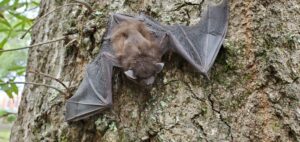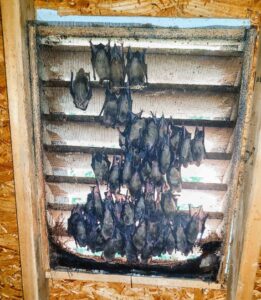 It’s Getting Quite Batty Around Here!
It’s Getting Quite Batty Around Here!
Fall is here…okay, it’s Georgia so who really knows what the weather is going to do? However, at some point, cooler weather will arrive and that means bats and other wildlife will begin to look for a cozy place to overwinter. Join me as we learn more about the world of the mysterious and amazing bat!
How many bat species are there anyway?
The world has almost 1,000 different species of bats, and the United States is home to about 40 of those varieties. We Georgians have identified about 16 types of bats in our own backyards. And in case bats bring forth the Dracula vision, none of the 3 vampire species are Georgia residents!
What kind of bats can Georgians expect to see?
We won’t go through a comprehensive list of Georgia bats, but I will mention a few of the common and cool varieties you might see flying through your night sky. One of the most common bats we see is the Little Brown bat which is 2 to 3 inches in length with a 9-to-11-inch wingspan. The fur of a little brown is varied shades of brown in color with a lighter underside. Another common bat in our area is the Eastern Pepestrelle which is a small bat at just 3 inches long and tends towards a yellowish-brown color. The Big Brown bat has a wingspan of about 13 inches and ranges in color from light to darker brown with black on the ears, muzzle, and wings. The biggest of the Georgia bat species is the Hoary bat a whopping 16 inches in wingspan. Their coloration is quite unique with silvery white fur and a throat patch of yellow. Each individual hair (not that I will look closely enough to verify this information) is a darker color at the base with a yellow middle and black ends with a white tip! What a combo! I would hate to be the fur stylist trying to get that ‘au natural’ appearance for Mrs. Hoary Bat.
Where do bats live?
While most people think of caves as being the proper nesting sites for bats, the fact is that caves are only one of a number of bat homes. During the summer, bats temporarily roost on porches and patios or even in garages. Wintertime hibernation is a different story as the bat needs a bit more temperature and humidity regulation for survival. A cave is indeed a good choice for a bat but may not be readily available. In that situation, the hollow of a tree or underneath a bridge are alternative nesting sites. Now, there’s one more location we have yet to discuss and that, my Canton friends, is the real issue at hand.
The problem is when an expectant momma bat in suburbia sees your attic as a quality home away from home and settles in for the duration. Not to worry, we will tackle this issue in a bit. For now, hang on as we talk about the good things bats do for our environment and for your backyard. Bats have tremendous value, and I’ll tell you why!
rabies and histoplasmosis are generally more common in mid-western states than in Georgia. Enough said, you don’t want bats in your attic, yet there is no reason to panic either!
What to do when bats want to join the family
Prevention is first and foremost. Remember a tiny hole can allow entrance to a bat so regular inspection and maintenance by the homeowner helps stop problems before they start. Also, creating a bat-friendly environment outside of your home in wooded areas allows the bats a suitable site for overwintering.
If you do decide to create bat boxes, there are some helpful suggestions to follow for the best results. Place the boxes 15 to 20 feet off the ground in a sunny area. Make sure the box is darker in color since it will absorb more sunlight and create a warmer home for the bats who prefer 80–100-degree temperatures. And keep the box wasp-free since bats aren’t fond of guests. Do understand that bats take their time choosing a home so it could take a couple of seasons before they move into your new construction. Be patient, and by the way, patience is a theme to remember when it comes to bats.
The positives of bats in your yard
To begin with, bats are the pest control experts of the mammal world! A single bat can eat up to 2,000 insects every single night! To break that down, that’s hundreds in one hour. When you consider the nasty mosquito bites we are often subjected to during a nighttime walk or porch sit, the bat is extremely helpful, even heroic! And if you enjoy gardening, you will be happy to know they consume moths and beetles that cause agricultural damage. To put it into a money perspective, bats save US corn growers more than a billion (yes with a B) dollars every year. Go bats go!!!
Bats also help with pollination and seed dispersal. Every creature has a purpose in our ecosystem, and the loss of any species is negatively impactful to our world. With habitat invasion and fungus-causing issues such as white-nose syndrome, it is imperative that we understand and respect the humble bat’s fight for survival.
The negatives of bats in your attic!
For all the positives of bats in nature, bats in the attic are another matter entirely. Bats can enter through a tiny hole as small as ½ of an inch, so it is vital that you do frequent maintenance checks of your home to be sure it is sealed well. Prevention, prevention!
Once bats are officially IN the attic, there are myriad problems for the homeowner. First, the smell of bat guano can be quite offensive. Secondly, there can be brown discoloration from the areas where the bats are entering and leaving your home. Then there are the midnight attic disturbances that bring a chill to any peacefully sleeping homeowner as the bats move in and out of your home. Most frightening is the possibility of diseases such as rabies or histoplasmosis (caused by inhaling the spore stage of a fungus that grows in bat guano environments). Supposedly, rabies is a rare circumstance as only 5% of bats tested have been found to carry it.
If prevention has not kept the bats out and you have an issue, there’s still hope for a bat-free home. Just know that the process will take some patience (there’s that word) on your part and some experience and knowledge for the professional involved in the process.
And yes, you need to call a professional.
Why, you may ask, do I need a professional? As stated before, bats are incredibly important and helpful in their natural habitat, so it is wise to create a humane eviction process that gives everyone (including the bats) a chance to survive and thrive. This involves understanding the life cycle of the bats in our area and the exclusion process. Exclusion involves a professional locating the entry points of the bats and then installing a one-way door that allows them to exit but not re-enter the home. Then, we wait and watch. This is all great except for one very important detail: what if the bats can’t leave?
Of course, when your attic is housing bats, you typically want them out ASAP; however, this is not always possible due to the well-being of baby bats plus you really don’t want dead bats in the house. From approximately April 1st to the end of July or mid-August, baby bats are too small to fly and will get trapped in your attic if exclusion is done during this time period.
This is cruel not to mention illegal as bats are protected by Georgia law. Another timing factor to consider is getting the bats out before cold weather sets in so there is a narrow window to resolve bat issues in a home.
Canton Termite is experienced and knowledgeable in the area of bats and other wildlife visitors in your home. If you have a problem with bats in the attic, give us a call at 770-479-1598 and we will help you live in a home that is bat-free!
By: Robin
